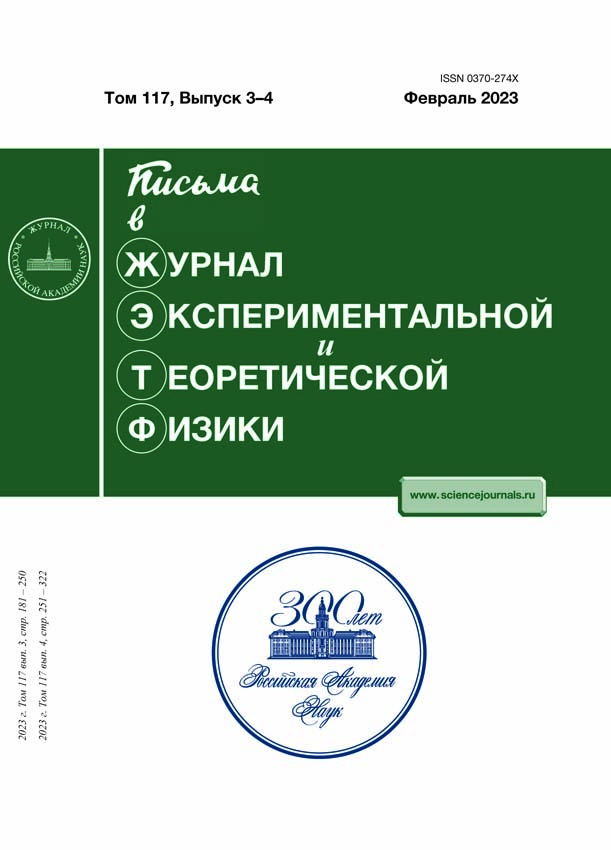Generation of Short Pulses by Filtering Phase-Modulated CW Laser Radiation
- Autores: Shakhmuratov R.N1
-
Afiliações:
- Zavoisky Physical–Technical Institute, FRC Kazan Scientific Center, Russian Academy of Sciences
- Edição: Volume 117, Nº 3-4 (2) (2023)
- Páginas: 193-200
- Seção: Articles
- URL: https://rjraap.com/0370-274X/article/view/663505
- DOI: https://doi.org/10.31857/S1234567823030035
- EDN: https://elibrary.ru/OWGNWN
- ID: 663505
Citar
Texto integral
Resumo
A method for generating short pulses with a high repetition rate is proposed. It is based on periodic modulation of the radiation phase of a CW laser and subsequent filtering through a narrow-band frequency filter. At the output of the filter, a sequence of short pulses is generated with a period equal to half the modulation period. In the case of a resonant filter using atoms, ions or molecules with a narrow absorption line, the appearance of pulses can be explained by constructive interference of the incident radiation with radiation coherently scattered by resonant particles. An alternative explanation of the pulse generation in the general case, when frequency filters operating on other principles are used, is based on the interference of the spectral components remaining after filtering. The method can be applied for time division multiplexing to transmit digital information through a single channel at high speed. The advantage of the proposed method is the use of phase modulation (not strictly periodic), integrated with frequency filtering to generate pulses and encode information simultaneously in one circuit, while in other known methods, information is introduced into a sequence of regularly generated pulses using additional amplitude modulation.
Sobre autores
R. Shakhmuratov
Zavoisky Physical–Technical Institute, FRC Kazan Scientific Center, Russian Academy of Sciences
Autor responsável pela correspondência
Email: shakhmuratov@mail.ru
420029, Kazan, Russia
Bibliografia
- W. H. Knox, IEEE J. Sel. Top. Quantum Electron. 6, 1273 (2000).
- T. J. Kippenberg, A. L. Gaeta, M. Lipson, and M. L. Gorodetsky, Science 361, 567 (2018).
- A. L. Gaeta, M. Lipson, and T. J. Kippenberg, Nat. Photonics 13, 158 (2019).
- A. M. Weiner, Nat. Photonics 11, 533 (2017).
- T. J. Kippenberg, R. Holzwarth, and S. A. Diddams, Science 332, 555 (2011).
- N. Yu. Dmitriev, S. N. Koptyaev, A. S. Voloshin, N. M. Kondratiev, K. N. Min'kov, V. E. Lobanov, M. V. Ryabko, S. V. Polonsky, and I. A. Bilenko, Phys. Rev. Appl. 18, 034068 (2022).
- P. Marin-Palomo, J. N. Kemal, M. Karpov, A. Kordts, J. Pfei e, M. H. P. Pfei er, P. Trocha, S. Wolf, V. Brasch, M. H. Anderson, R. Rosenberger, K. Vijayan, W. Freude, T. J. Kippenberg, and C. Koos, Nature 546, 274 (2017).
- V. Torres-Company, Nature 546, 214 (2017).
- N. Akhmediev, A. Ankiewicz, J.-M. Soto-Crespo, and P. Grelu, International Journal of Bifurcation and Chaos 19, 2621 (2009).
- K. Saha, Y. Okawachi, B. Shim, J. S. Levy, R. Salem, A. R. Johnson, M. A. Foster, M. R. E. Lamont, M. Lipson, and A. L. Gaeta, Opt. Express. 21, 1335 (2013).
- M. Zhang, B. Buscaino, C. Wang, A. Shams-Ansari, C. Reimer, R. Zhu, J. M. Kahn, and M. Lonˇcar, Nature 568, 373 (2019).
- E. Podivilov, S. Smirnov, and B. Sturman, JETP Lett. 115, 601 (2022).
- T. Otsuji, M. Yaita, T. Nagatsuma, and E. Sano, IEEE J. Sel. Topics in Quan. Electron. 2, 643 (1996).
- P. V. Mamyshev, Opt. Lett. 19, 2074 (1994).
- V. Torres-Company, J. Lancis, and P. Andr'es, Opt. Express 14, 3171 (2006).
- J. E. Bjorkholm, E. H. Turner, and D. B. Pearson, App. Phys. Lett. 26, 564 (1975).
- D. Grischkowsky and M. M. Loy, Appll. Phys. Lett. 26, 156 (1975).
- T. Kobayashi, H. Yao, K. Amano, Y. Fukushima, A. Morimoto, and T. Sueta, IEEE J. Quantum Electron. 24, 382 (1988).
- E. A. Golovchenko, C. R. Menyuk, G. M. Carter, and P. V. Mamyshev, Electron. Lett. 31, 2198 (1995).
- D.-S. Kim, M. Arisawa, A. Morimoto, and T. Kobayashi, IEEE J. Sel. Top. Quantum. Electron. 2, 493 (1996).
- T. Komukai, T. Yamamoto, and S. Kawanishi, IEEE Photonics Technonol. Lett. 17, 1746 (2005).
- R. N. Shakhmuratov, F. G. Vagizov, V. A. Antonov, Y. V. Radeonychev, M. O. Scully, and O. Kocharovskaya, Phys. Rev. A 92, 023836 (2015).
- R. N. Shakhmuratov, Phys. Rev. A 95, 033805 (2017).
- C. R. Fern'andez-Pousa, R. Maram, and J. Azan'a, Opt. Lett. 42, 2427 (2017).
- A. Sheveleva and C. Finot, Microw. Opt. Technol. Lett. 63, 1616 (2021).
- R. N. Shakhmuratov, Laser Phys. 32, 105401 (2022).
- R. N. Shakhmuratov, Phys. Rev A. 100, 043823 (2019).
- R. N. Shakhmuratov, J. Lightwave Techn. 40, 1895 (2022).
- P. Helist¨o, I. Tittonen, M. Lippmaa, and T. Katila, Phys. Rev. Lett. 66, 2037 (1991).
- R. N. Shakhmuratov, F. Vagizov, and O. Kocharovskaya, Phys. Rev. A 84, 043820 (2011).
- R. N. Shakhmuratov, F. G. Vagizov, and O. A. Kocharovskaya, Bull.Russ. Acad. Sci.: Phys. 78, 199 (2014).
- R. N. Shakhmuratov, Phys. Rev. A 85, 023827 (2012).
- C. C. Kwong, T. Yang, D. Delande, R. Pierrat, and D. Wilkowski, Phys. Rev. Lett. 115, 223601 (2015).
- M. D. Crisp, Phys. Rev. A 1, 1604 (1970).
- F. J. Lynch, R. E. Holland, and M. Hamermesh, Phys. Rev. 120, 513 (1960).
- F. J. Harris, Phys. Rev. 124, 1178 (1961).
- V. Gruˇzinskis, J. H. Zhao, P. Shiktorov, and E. Starikov, Material Sciences Forum 297-298, 341 (1999).
- T. Mizawa, IMPATT Diodes in Semiconductors and Semimetals Part B, ed. by R. K. Willardson and A. C. Beer, Academic Press, N.Y., NY, USA (1971), v. 7, p. 371.
- J. F. Chen, S. Wang, D. Wei, M. M. T. Loy, G. K. L. Wong, and S. Du, Phys. Rev. A 81, 033844 (2010).
- J. F. Chen, H. Jeong, L. Feng, M. M. T. Loy, G. K. L. Wong, and S. Du, Phys. Rev. Lett. 104, 223602 (2010).
- Z. Jiang, D. E. Leaird, and A. M. Weiner, J. Quantum Electron. 42, 657 (2006).
Arquivos suplementares










